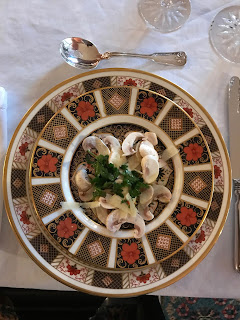I try to find a time each January to cook for my friends in
Wilmington. They are always having us for drinks so I feel guilty going to
their house and not doing something in return. I usually do a curry but decided
to do a goulash since I did enjoy this (stew or soup) in Vienna. I chose a
simple mushroom salad for starters and for dessert (my friends love dessert) a
banana sticky toffee pudding. What could be more enjoyable to eat by the fire
on a cold winter night and share this meal with friends?
Both recipes are from the January 2018 issue of ‘Food and
Wine’ magazine.
Hungarian Goulash
Serves 8
6 oz. thinly sliced bacon, chopped
2 ½ lb. well-marbled boneless beef chuck, cut into 1 ½ -inch
pieces
Kosher salt and pepper
2 onions, chopped
¼ cup Hungarian sweet paprika (I used regular paprika since
I could not find the sweet and found the goulash a little bitter so added more
apple cider vinegar and some lemon juice) and this made it taste fine.
1 Tbsp. tomato paste
½ tsp. caraway seed
2 Tbsp. apple cider vinegar, divided
1 ½ lb. small Yukon Gold potatoes, cut into 1-inch pieces
1 green bell pepper, chopped (I used a red pepper)
2 tsp. fish sauce, optional (gave it a little more kick)
Sour cream and toasted rye bread, for serving
In a large Dutch oven, cook bacon over moderate heat until
crisp, about 7 minutes. Using a slotted spoon, transfer bacon to a plate,
leaving fat in pan.
Season beef with salt and pepper. In batches, add beef to
pot, and cook in bacon fat over moderately high heat until browned all over,
about 5 minutes per batch. Using a slotted spoon, transfer beef to plate with
bacon.
Add ¼ cup of water and onions to pot. Cook, stirring with a
wooden spoon and scraping up browned bits, until all liquid is evaporated and
onion is softened, about 6 minutes. Add paprika, tomato paste, and caraway
seeds; cook, stirring, for 1 minute.
Add 7 cups of water and 1 tablespoon of the apple cider
vinegar; return the meat and any accumulated juices to the pot. Bring the
goulash to a boil, cover partially, and simmer over low heat for 1 ½ hours.
Add potatoes and bell pepper to pot, and simmer, partially
covered, over low heat until beef is very tender and sauce is slightly
thickened, about 1 hour.
Stir in fish sauce, if using and remaining 1 tablespoon
apple cider vinegar. Season with salt and pepper. Ladle into bowls and serve
with sour cream and rye bread.
Shaved Mushroom and Pecorino Salad
Serves 8
1/3 cup extra-virgin olive oil, plus some for drizzling
¼ cup fresh lemon juice
2 Tbsp. chopped parsley
¼ tsp. crushed red pepper
Kosher salt and pepper
1 lb. fresh white button mushrooms, very thinly slices
(preferably on a mandolin)
2 oz. pecorino cheese, shaved
In a small bowl, whisk the olive oil with the lemon juice,
parsley and red pepper. Season generously with salt and pepper.
Spread half the mushrooms on a large platter. Drizzle with
half of the dressing and sprinkle with half of the cheese. Repeat with the
remaining mushrooms, dressing, and cheese. Drizzle with olive oil and serve.
Banana Sticky Toffee Pudding
Serves 9
½ cup unsalted butter, at room temperature
¾ cup boiling water
6 oz. pitted dates, chopped (1 cup)
Tsp. baking soda
½ cups all-purpose
flour
1 tsp. baking powder
½ tsp. kosher salt
1 ¼ cups light brown sugar
2 large eggs
2 medium-size overripe bananas, mashed (1 cup)
½ cup heavy cream
Unsweetened whipped cream, for serving.
Preheat oven to 350°. Grease a 9-inch square metal pan
with butter. In a small heatproof bowl, pour the boiling water over the dates;
stir in the baking soda. In a medium bowl, whisk together the flour, baking
powder, and salt.
In the bowl of a stand mixer fitted with the paddle, beat ¼
cup of the butter with ¾ cup of the brown sugar at medium speed until light and
fluffy, about 4 minutes. Beat in the eggs, one at a time. At low speed beat in
the flour mixture until just combined. Add the date mixture and bananas, and
beat at low speed until just combined.
Scrape the batter into the prepared pan, and bake until a
toothpick inserted in the center comes out clean, about 30 minutes.
Meanwhile, in a small saucepan, combine the heavy cream, the
remaining ¼ cup of butter, and the remaining 1 cup of brown sugar. Bring to a
gentle boil over moderate heat, and cook until slightly thickened and deep
golden, about 3 minutes. Keep warm.
Transfer the pan to a wire rack. Using a skewer or
toothpick, poke holes all over the cake. Pour half of the warm sauce over the
cake, and let stand until absorbed, about 10 minutes. Serve warm with the
remaining sauce and the whipped cream.













